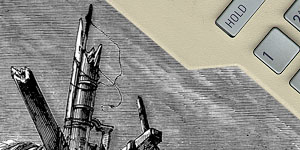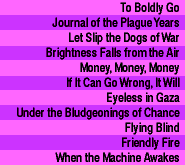


Let Slip the Dogs of War
On the evening of Monday, February 25, 1991, an Iraqi Scud missile was forty kilometers above the surface of the earth; it had just reentered the atmosphere at hypersonic speeds and was inbound to Dhahran, Saudi Arabia. It was to be the last Scud missile fired in the Gulf War.Iraq had modified the short-range, surface-to-surface Russian Scud to hit targets farther away. The homemade changes, however, made the missile unstable, so it frequently broke up in flight and that, unintentionally, made the job of the American Patriot antimissile missile harder.
The Patriot, designed as a short-range surface-to-air missile, was meant to shoot down aircraft or slow-moving missiles. It didn't have the speed, range, and multiple warheads needed to handle Scud fragments falling at two and a quarter kilometers a second. To hit such targets, it would have had to predict where to aim multiple warheads to hit targets closing at a combined velocity of about three and a half kilometers a second---roughly ten times the speed of sound. If its timing was off by even a tenth of a second, it would miss by well over three hundred meters. In fact, the computer software the Patriot used to draw its small tracking window was losing one hundred-millionth of a second every second. A few lines in a million-plus-line computer program were flawed. Usually, that didn't matter. Each Patriot battery was only supposed to work for fourteen hours at a stretch, after which time the cumulative error was still insignificant.
But there was a war on. And people under stress are forgetful. Of the two Patriot batteries nearest Dhahran, one was down for repairs and the other had been in continuous use for four days. The timing flaw had by then risen so much that the tracking window couldn't be drawn accurately enough, which was what happened on February 25, 1991. That day the remaining Dhahran Patriot battery was scanning the sky with its five thousand phased-array radar elements. When it detected a possible incoming missile and estimated its speed and distance, it narrowed its scanning to a high-definition tracking window surrounding the potential target and tried to lock on to it. By then, though, it had lost its target. It presumed that there was a glitch in its system and returned to scanning the evening sky, ignoring the swiftly falling Scud fragments.
Despite 15,000 million dollars spent on development and a per-missile cost of almost a million dollars, twenty-eight American service men and women died that night, and ninety-eight others were wounded.
Although machines have become smarter through computer software, we create that software. And we make mistakes. The more complex the system, the more mistakes we make. So, as computer systems grow ever more complex, the chance of missing something vital increases dramatically.
On the other hand, fewer than five hundred Allied troops died during the war---less than a tenth of them by enemy fire. So Iraqi troops managed to kill directly, roughly, fifty Allied troops---half of them in the Dhahran Scud attack. That number doesn't begin to match the estimated fifty to one hundred thousand Iraqi soldiers and civilians killed in the war. Of course, that disparity wasn't due only to smart weapons. Still, given the choice between smart weapons---even ones with potentially flaky software---and normal dumb ones, every soldier on earth now wants smart weapons.